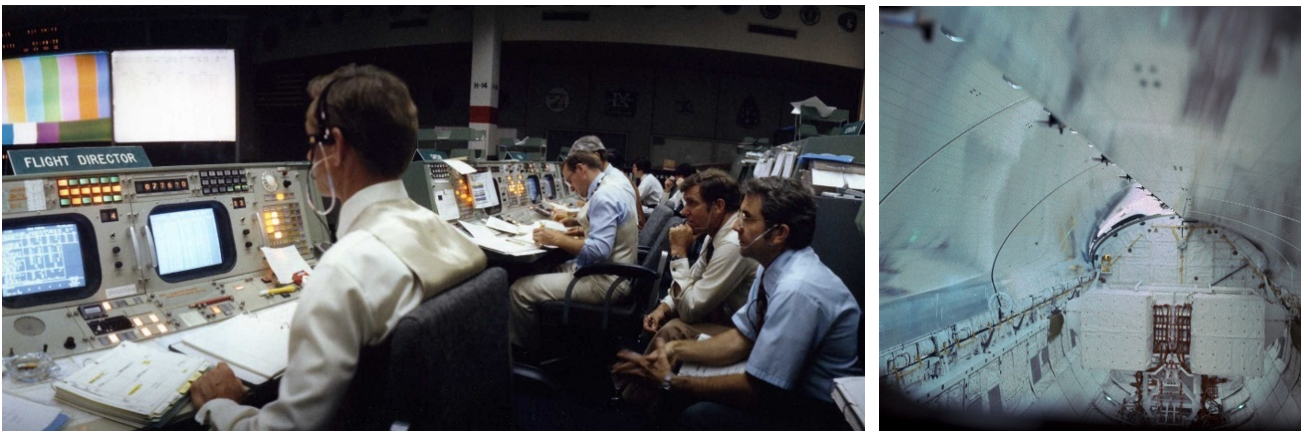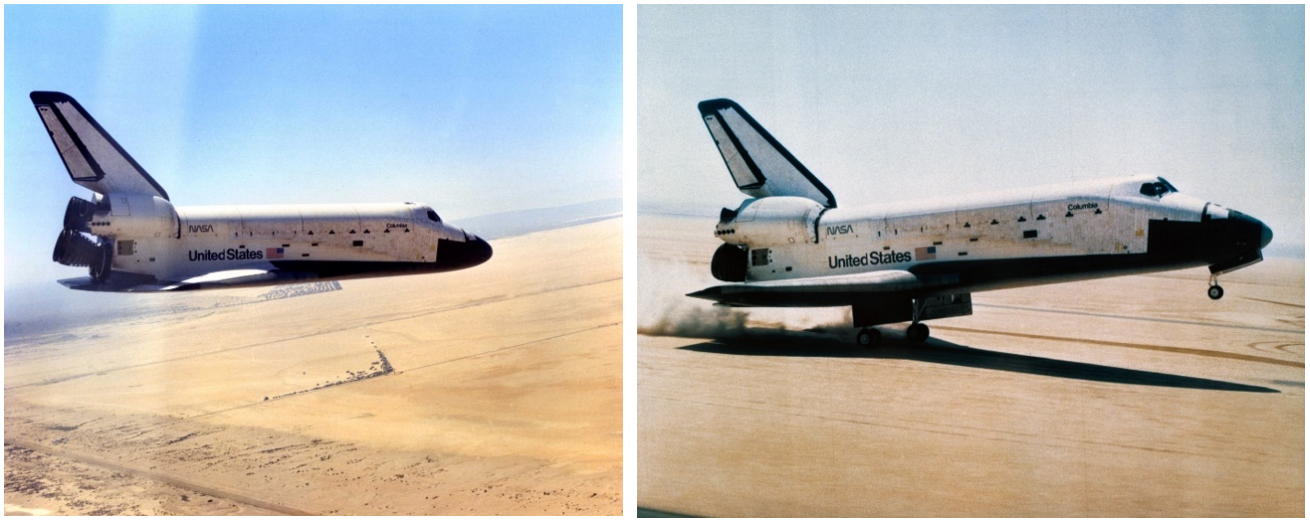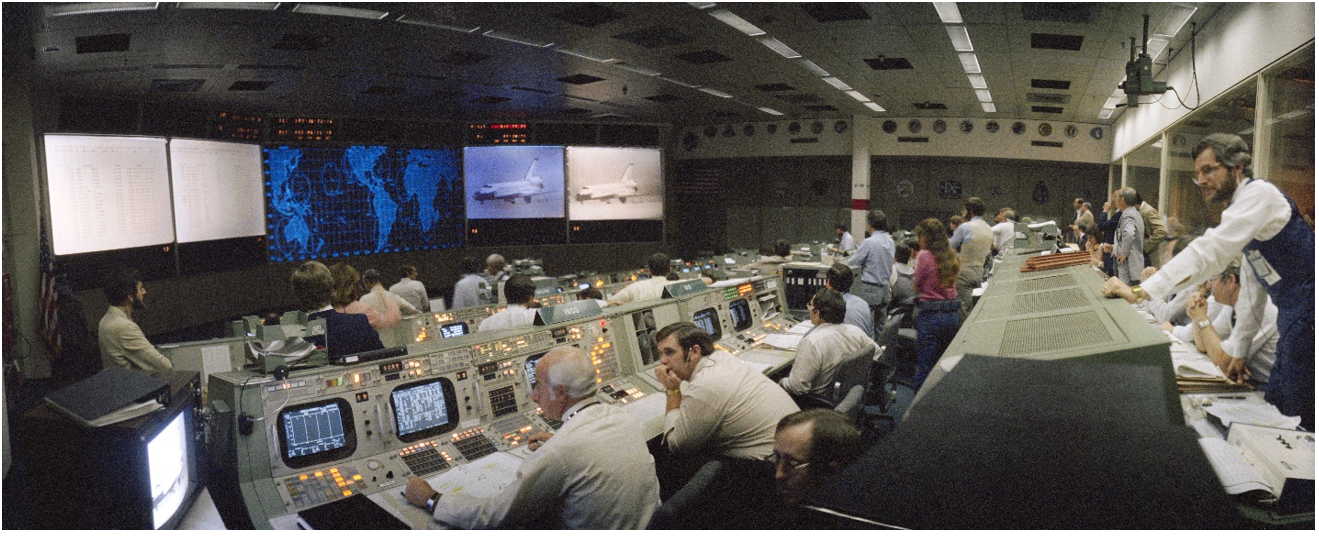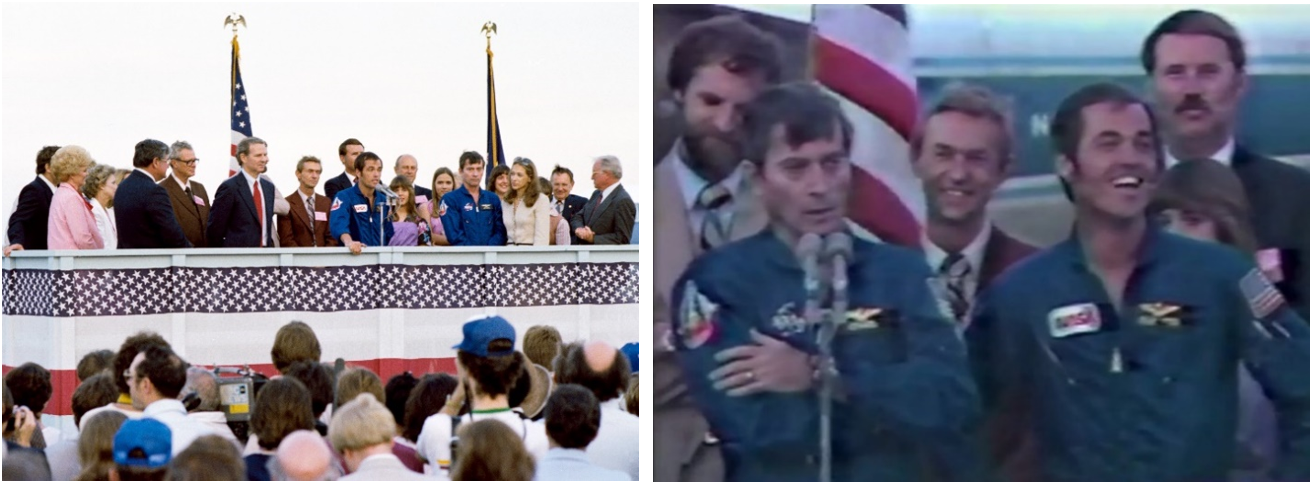40 Years Ago: Space Shuttle Columbia Returns Home
Following their spectacular launch and two days of successful orbital operations, on April 14, 1981, STS-1 Commander John W. Young and Pilot Robert L. Crippen brought Space Shuttle Columbia back to Earth. During their last day in space, they completed a few more tests of the world’s first reusable spacecraft before closing Columbia’s payload bay doors. They maneuvered the vehicle to the re-entry attitude and fired its engines to drop them out of orbit. Following an automated descent through the atmosphere, Young took over manual control and flew Columbia to a precise touchdown on the lakebed runway at NASA’s Dryden Flight Research Center, now NASA’s Armstrong Flight Research Center, at Edwards Air Force Base (AFB) in California’s Mojave Desert.
 Left: Naples and Mt. Vesuvius, Italy, photographed by the STS-1 crew. Middle: The Great Kavir Salt Desert, Iran, photographed by the STS-1 crew. Right: Photograph taken by the STS-1 crew of the Mojave Desert region of California, including the Rogers Dry Lake at NASA’s Dryden Flight Research Center, now NASA’s Armstrong Flight Research Center, Columbia’s landing site, at the center of the photograph. Credits: NASA
Left: Naples and Mt. Vesuvius, Italy, photographed by the STS-1 crew. Middle: The Great Kavir Salt Desert, Iran, photographed by the STS-1 crew. Right: Photograph taken by the STS-1 crew of the Mojave Desert region of California, including the Rogers Dry Lake at NASA’s Dryden Flight Research Center, now NASA’s Armstrong Flight Research Center, Columbia’s landing site, at the center of the photograph. Credits: NASA
As they slept during their second and final night in space, an alarm awakened Young and Crippen, set off by a temperature sensor in one of Columbia’s three auxiliary power units (APUs). One of the heaters in the APU, used to control Columbia’s aerodynamic surfaces during flight through the atmosphere, had apparently failed. From the Mission Control Center (MCC) at NASA’s Johnson Space Center in Houston, capsule communicator (capcom) astronaut Daniel C. Brandenstein, part of Flight Director Neil B. Hutchinson’s Silver Team of flight controllers, advised the astronauts to switch to a backup heater, resolving the problem so they could resume their sleep. On the morning of re-entry day, Young and Crippen were already up and cooking breakfast when MCC played their reveille wake-up song.
Prior to preparing for re-entry, the crewmates took more photographs of Earth and tested Columbia’s reaction control system (RCS) thrusters and flight control surfaces. In the MCC, Flight Director Donald R. Puddy and his Crimson Team of flight controllers, with astronaut Joseph P. Allen serving as capcom, took their consoles for the remainder of the mission. Allen informed Young and Crippen that the backup APU heater had also failed, but that the unit would still be operable during re-entry and landing.
Young and Crippen donned their pressure suits and closed the payload bay doors. Using Columbia’s RCS thrusters, they oriented the vehicle with its orbital maneuvering system (OMS) engines facing in the direction of flight for the re-entry burn. Over the Indian Ocean, they fired the two OMS engines for 160 seconds to reduce their velocity and begin their descent back to Earth.
 Left: View of the Mission Control Center at NASA’s Johnson Space Center in Houston, with Charles R. “Chuck” Lewis, left, at the flight director console, and STS-1 backup crew members Joe H. Engle and Richard H. Truly at right. Right: Closing of Columbia’s payload bay doors in preparation for re-entry. Credits: NASA
Left: View of the Mission Control Center at NASA’s Johnson Space Center in Houston, with Charles R. “Chuck” Lewis, left, at the flight director console, and STS-1 backup crew members Joe H. Engle and Richard H. Truly at right. Right: Closing of Columbia’s payload bay doors in preparation for re-entry. Credits: NASA
Shortly after passing over the Guam tracking station, at an altitude of 400,000 feet, Columbia encountered the upper layers of Earth’s atmosphere. For about 16 minutes, the heat of re-entry created a layer of plasma around the vehicle, blocking all communications between the ground and the spacecraft. During re-entry, the vehicle’s leading edges experienced maximum temperatures of 2,750 degrees Fahrenheit — but less than 600 degrees on the fuselage.
Ground stations made radar contact with Columbia at an altitude of 165,000 feet and a range of 470 miles. Communications were re-established with Columbia traveling at Mach 10.3, more than 10 times the speed of sound. When they crossed the California coastline at an altitude of 141,000 feet, with 275 miles to go to touchdown, Crippen exclaimed, “What a way to come to California!”
Columbia’s autopilot executed several roll reversals to bleed off speed, and Young took manual control of the vehicle at Mach 4.8 at an altitude of 112,000 feet. Columbia went subsonic at 51,000 feet and, as it flew over Edwards AFB, created a double sonic boom heard by the 600,000 spectators assembled to witness the landing. Completing a sweeping 210-degree turn, Young aligned Columbia with Runway 23 on the Rogers Dry Lake at Dryden.
Astronaut Jon A. McBride, flying in a T-38 Talon chase aircraft, rendezvoused with Columbia, with fellow astronaut George D. “Pinky” Nelson photographing the vehicle’s underside to document any damage prior to landing and rollout on the desert runway. Crippen manually lowered the landing gear at about 400 feet. Columbia’s main gear touched down at a speed of 211 mph, followed a few seconds later by the nose gear, and the vehicle rolled 8,993 feet before coming to a stop.
Young jokingly asked, “Do I have to take it up to the hangar, Joe?” to which capcom Allen replied, “We’re going to dust it off first.”
A jubilant Young commented, “This is the world’s greatest flying machine, I’ll tell you that. It worked super.”
Columbia was home after two days, six hours, 20 minutes, and 53 seconds, having traveled more than 1 million miles during its 36 orbits around the planet.
 Left: View of Columbia on its final approach to Runway 23 at NASA’s Dryden Flight Research Center, taken from a chase plane, with the thousands of spectators visible in the distance just below Columbia. Right: Touchdown! Columbia touches down on Runway 23, ending the highly successful STS-1 mission. Credits: NASA
Left: View of Columbia on its final approach to Runway 23 at NASA’s Dryden Flight Research Center, taken from a chase plane, with the thousands of spectators visible in the distance just below Columbia. Right: Touchdown! Columbia touches down on Runway 23, ending the highly successful STS-1 mission. Credits: NASA
In the MCC, Flight Director Puddy allowed his team exactly 15 seconds of exultant cheering before requiring them to return to work to help Young and Crippen power down the spacecraft. On the runway, ground crews approached the vehicle to purge it of toxic chemicals and prepare for the crew’s safe egress. Young emerged from Columbia one hour and eight minutes after landing and completed an exuberant walk-around of the vehicle, with Crippen following a few minutes later.
 View in the Mission Control Center at NASA’s Johnson Space Center shortly after touchdown of Space Shuttle Columbia, ending STS-1. Credits: NASA
View in the Mission Control Center at NASA’s Johnson Space Center shortly after touchdown of Space Shuttle Columbia, ending STS-1. Credits: NASA
 Left: Ground personnel approach Columbia shortly after touchdown to begin safing the vehicle. Middle: Ground personnel begin to safe Columbia. Right: Taken from inside Columbia, the mobile White Room prepares to drive up to the vehicle to begin the process of crew egress. Credits: NASA
Left: Ground personnel approach Columbia shortly after touchdown to begin safing the vehicle. Middle: Ground personnel begin to safe Columbia. Right: Taken from inside Columbia, the mobile White Room prepares to drive up to the vehicle to begin the process of crew egress. Credits: NASA
 Left: An exuberant STS-1 Commander John W. Young bounds down the steps from Columbia to begin his inspection of the vehicle. Middle: STS-1 Pilot Robert L. Crippen descends the steps from Columbia to join Young on the runway. Right: Young, left, and Crippen greet ground personnel as they board the astronaut van. Credits: NASA
Left: An exuberant STS-1 Commander John W. Young bounds down the steps from Columbia to begin his inspection of the vehicle. Middle: STS-1 Pilot Robert L. Crippen descends the steps from Columbia to join Young on the runway. Right: Young, left, and Crippen greet ground personnel as they board the astronaut van. Credits: NASA
After a brief medical exam, Young and Crippen were reunited with their wives Susy and Ginny, respectively, and exchanged their pressure suits for lightweight flight suits. During a welcome ceremony that included California Governor E. Gerald “Jerry” Brown, acting NASA Administrator Alan M. Lovelace, and Dryden Director Isaac T. “Ike” Gillam, they addressed an assembled crowd of several hundred well-wishers. Young spoke of the space shuttle’s promise and America’s future in space, saying, “I think we’ve got a fantastic and remarkable capability here. We’re really not too far, the human race isn’t, from going to the stars.”
Crippen added, “As the rookie of the group, I can say that waiting 12 years to get my flight in space was well worth it.”
 Left: NASA Kennedy Space Center Deputy Director Gerald D. Griffin guides astronauts Robert L. Crippen, left, and John W. Young toward the podium to address the crowd at NASA’s Dryden Flight Research Center after their return from the STS-1 mission. Right: Young addresses the crowd as his wife Susy and crewmate Crippen and his wife Ginny look on. Credits: NASA
Left: NASA Kennedy Space Center Deputy Director Gerald D. Griffin guides astronauts Robert L. Crippen, left, and John W. Young toward the podium to address the crowd at NASA’s Dryden Flight Research Center after their return from the STS-1 mission. Right: Young addresses the crowd as his wife Susy and crewmate Crippen and his wife Ginny look on. Credits: NASA
With their wives, Young and Crippen, along with NASA officials, flew to Ellington AFB near Johnson, where an enthusiastic crowd welcomed them home. President Reagan, still recuperating following an assassination attempt two weeks earlier, sent his chief of staff, James A. Baker, as his personal representative to welcome Young and Crippen back to Houston. The mayor of Houston, James J. “Jim” McConn, also attended.
The three STS-1 flight directors, Hutchinson, Puddy, and Charles R. “Chuck” Lewis, stood behind the astronauts during the ceremony. Young and Crippen both acknowledged the ongoing support of their wives and praised each other on their performance during the mission. Young told the crowd that included many Johnson employees and contractors, “There aren’t words to express just how grateful we are to everybody that did so much to help this mission go successfully.”
 Left: In blue flight suits, STS-1 astronauts Robert L. Crippen, left, and John W. Young address the crowd from the podium at Ellington Air Force Base near NASA’s Johnson Space Center in Houston. Right: Young, left, addressing the crowd at Ellington as Crippen reacts to a joke, with the three STS-1 flight directors (Neil B. Hutchinson, left, Charles R. “Chuck” Lewis, and Donald R. Puddy) standing behind them. Credits: NASA
Left: In blue flight suits, STS-1 astronauts Robert L. Crippen, left, and John W. Young address the crowd from the podium at Ellington Air Force Base near NASA’s Johnson Space Center in Houston. Right: Young, left, addressing the crowd at Ellington as Crippen reacts to a joke, with the three STS-1 flight directors (Neil B. Hutchinson, left, Charles R. “Chuck” Lewis, and Donald R. Puddy) standing behind them. Credits: NASA
Meanwhile, ground crews at Dryden towed Columbia from Runway 23 to the mate-demate device where, following a detailed inspection, they mounted it atop a Boeing 747 Shuttle Carrier Aircraft (SCA). On April 27, the SCA carrying Columbia took off from Edwards AFB for the trip back to NASA’s Kennedy Space Center in Florida, arriving there the next day. The following morning, after demating it from the SCA, the workers towed Columbia to the Orbiter Processing Facility to begin processing it for its next mission, STS-2, then scheduled for October 1981.
 Left: At NASA’s Dryden Flight Research Facility, ground crews tow Columbia to the mate-demate device as the Boeing 747 Shuttle Carrier Aircraft (SCA) approaches at upper left. Right: The SCA carrying Columbia departs Dryden for the ferry flight back to NASA’s Kennedy Space Center in Florida. Right: After arriving at Kennedy, the SCA carrying Columbia approaches the mate-demate device. Credits: NASA
Left: At NASA’s Dryden Flight Research Facility, ground crews tow Columbia to the mate-demate device as the Boeing 747 Shuttle Carrier Aircraft (SCA) approaches at upper left. Right: The SCA carrying Columbia departs Dryden for the ferry flight back to NASA’s Kennedy Space Center in Florida. Right: After arriving at Kennedy, the SCA carrying Columbia approaches the mate-demate device. Credits: NASA
On April 23, 1981, Young and Crippen held a press conference in Johnson’s main auditorium. They presented a video (see below) of their recently completed STS-1 mission and answered reporters’ questions. At the end of the session, Young introduced the prime crew for STS-2, Commander Joe H. Engle and Pilot Richard H. Truly, who had served as backups for STS-1. He also introduced their backups, Thomas K. Mattingly and Henry W. “Hank” Hartsfield.
Engle and Truly unveiled the patch for their upcoming mission, the first to fly a crewed spacecraft a second time. In a symbolic gesture, Young presented Engle with a large cardboard key with the word “Columbia” written on it, prompting Engle to comment, “Would you buy a used spacecraft from this gentleman?” — meaning Young.
 Left: STS-1 astronauts Robert L. Crippen, left, and John W. Young during the postflight press conference. Middle: At the end of the press conference, Young, far right, introduces STS-2 prime and backup crew members Henry W. Hartsfield, Thomas K. Mattingly, Richard H. Truly, and Joe H. Engle, as Crippen, far left, looks on. Right: STS-2 prime crew members Truly, left, and Engle display their mission patch and the key to Columbia to reporters.
Left: STS-1 astronauts Robert L. Crippen, left, and John W. Young during the postflight press conference. Middle: At the end of the press conference, Young, far right, introduces STS-2 prime and backup crew members Henry W. Hartsfield, Thomas K. Mattingly, Richard H. Truly, and Joe H. Engle, as Crippen, far left, looks on. Right: STS-2 prime crew members Truly, left, and Engle display their mission patch and the key to Columbia to reporters.
To be continued …







